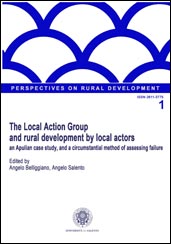|
Edited by Angelo Belliggiano, Angelo Salento |
Full Version (PDF)
|

e-ISSN: 2611-3775
ISBN:978-88-8305-136-4
DOI Code: 10.1285/i26113775n1
In a research programme entitled “New forms of governance for strategic territorial development”, coordinated by me as part of a Research Programme of National Interest (PRIN) in 2009, an analysis was conducted on six European regions. One of these was Apulia, in Italy. And Apulia has figured in a variety of volumes already published, dedicated to the discussion of existing and new intermediate institutions as possible agents for development within the framework of EU policies.
This publication, while placed appropriately within the above noted research framework, is dedicated entirely to the region of Apulia. Accordingly, the discussion continues to focus on the same subjects, called upon to be protagonists, likewise the same strategies, and the same questions (answered only in part). Looking at the overall experience — or at least the substantial part explored here — the picture is disappointing. Perhaps because the expectations were too many or too high. At all events, the judgement of "failure" that recurs repeatedly in certain of the interviews is undoubtedly a worry.
Table of Contents
| Frontespizio e pagine iniziali |
PDF
|
|
|
1-2 |
| Preface |
PDF
|
|
Mario Caciagli |
7-10 |
| Introduction |
PDF
|
|
Angelo Belliggiano, Angelo Salento |
11-16 |
| Territorialization and Europeanization of development. The case of Apulia |
PDF
|
|
Stefano De Rubertis, Marilena Labianca |
17-34 |
| Institutional and administrative reorganization: the implementation of territorial cohesion policies in Apulia |
PDF
|
|
Pierfrancesco Fighera |
35-46 |
| The role of intermediate institutions in community development. The case of LAGs |
PDF
|
|
Cosimo Talò |
47-58 |
| The impotent governance: a theory of Local Action Groups' failure |
PDF
|
|
Angelo Salento |
59-70 |
| Rural development and network failures: insights from an Apulian LAG |
PDF
|
|
Angelo Belliggiano |
71-84 |
Questo sito utilizza un cookie tecnico per consentire la corretta navigazione. Se vuoi saperne di più consulta l'
informativa estesa.
e-ISSN: 2611-3775


